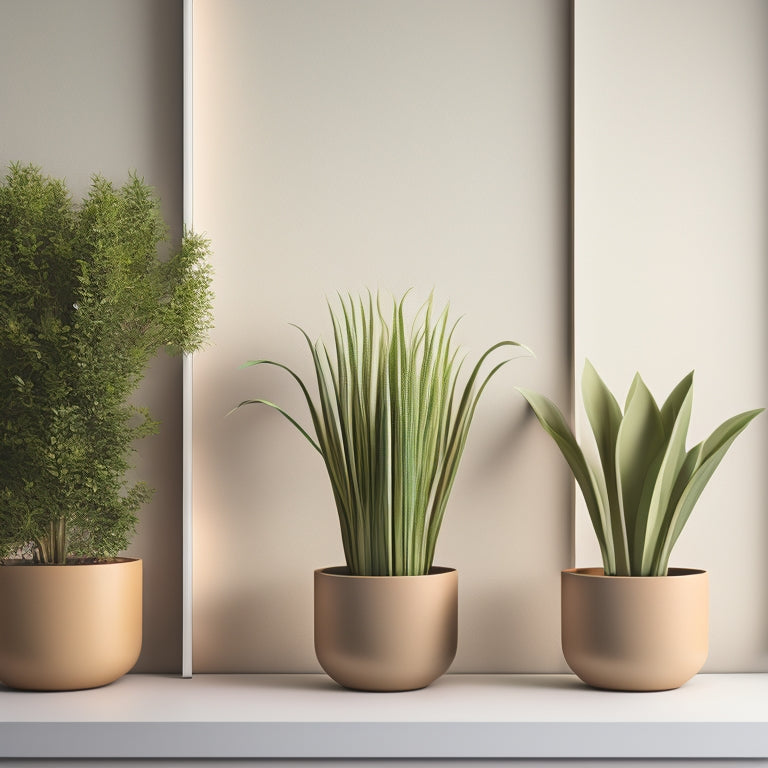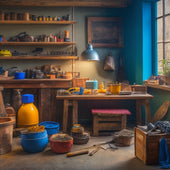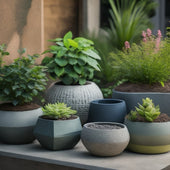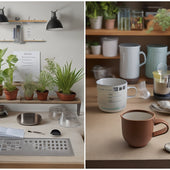
What's the Ideal Spacing for Your Planters
Share
When creating a planter, you'll want to take into account the ideal spacing between blocks and plants to guarantee a sturdy, visually appealing, and productive arrangement. Start by measuring the block width, including protrusions, and determining a 1-2 inch gap for drainage and aesthetics. Then, calculate the space required for each plant based on its mature size, growth habits, and soil characteristics. Factors like soil quality, moisture retention, and plant variety will also impact ideal spacing. By understanding these factors and using a spacing calculator tool, you can optimize your planter's layout, and with a few more considerations, you'll be on your way to a thriving and harmonious arrangement.
Key Takeaways
• Measure block width, including protrusions, to determine gap size, ensuring 1-2 inch spacing for drainage and aesthetics.
• Calculate planter spacing needs based on mature plant size, root development, and growth habits to ensure adequate growth space.
• Consider unique soil characteristics, such as nutrient availability, moisture retention, and structure, to adjust plant spacing needs.
• Use a spacing calculator tool to optimize planter layout, providing accurate measurements for precise planning and maximizing capacity.
• Balance size, shape, and color when arranging plants to ensure visual flow and harmony, and incorporate companion planting principles for enhanced growth.
Understanding Cinder Block Dimensions
Measure a standard cinder block to find it typically spans 7.625 inches in length, 7.625 inches in width, and 15.625 inches in height, with some variations possible depending on the manufacturer.
You'll notice that these dimensions can vary slightly between cinder block types, such as solid, hollow, or split-face blocks. Understanding these dimensions is essential for planning your planter arrangement.
When visualizing your block arrangement, consider the block's length and width to determine how they'll fit together. You can arrange them in a running bond pattern, where each block overlaps the one below it, or in a stacked bond pattern, where blocks are stacked directly on top of each other.
The height of the block will also impact your planter's overall height and the number of blocks you'll need.
As you plan your planter, keep in mind that precise block dimensions will guarantee a sturdy and level structure. By understanding the dimensions of your cinder blocks, you'll be able to create a well-designed and functional planter that meets your needs.
Measuring Space Between Blocks
As you arrange your cinder blocks, you'll need to calculate the space between them to guarantee a stable and visually appealing planter. The block arrangement will ultimately depend on the spacing techniques you employ. To achieve ideal results, follow these guidelines:
-
Measure the block width: Calculate the width of a single cinder block, including any protrusions or irregularities. This measurement will serve as your baseline for spacing.
-
Determine the gap size: Decide on the desired gap size between blocks. A general rule of thumb is to leave a 1-2 inch gap for drainage and aesthetic purposes.
-
Adjust for block variation: Consider the variation in block sizes and adjust your spacing accordingly. You may need to compensate for blocks that are slightly larger or smaller than average.
Calculating Planter Spacing Needs
When calculating planter spacing needs, you'll need to measure the distance between individual plants to guarantee they've enough room to grow.
You'll also need to assess the space requirements of each planter, taking into account factors like mature plant size and growth habits.
Measuring Plant Distance
By examining the mature size of your plants and considering the growth habits of neighboring species, you can accurately calculate the ideal spacing for your planters. This involves understanding how your plants will grow and interact with each other over time.
To measure plant distance effectively, consider the following factors:
-
Mature plant size: Check the plant tags or research the average mature size of your plants to determine how much space they'll require.
-
Root development: Consider the root growth patterns of your plants, as some species have more extensive root systems than others.
-
Growth habits: Think about how your plants will grow – will they spread out, grow upright, or trail down? This will help you determine the ideal spacing to accommodate their growth.
Assessing Space Needs
You'll need to calculate the total space required for each planter by factoring in the mature size of your plants, their root development, and growth habits. This is especially important in container gardening and vertical gardening, where space is limited. Consider the spread of the plant's foliage, as well as its root system, to guarantee proper growth and prevent overcrowding.
| Factor | Consideration |
|---|---|
| Mature Size | Measure the plant's expected height and width at maturity |
| Root Development | Account for the plant's root depth and spread |
| Growth Habits | Consider whether the plant is a spreader, climber, or upright grower |
When calculating planter spacing, don't forget to account for companion planting, seasonal adjustments, and drainage considerations. For example, plants with similar sunlight exposure requirements can be grouped together, while those with different requirements should be separated. Additionally, adjust planter spacing based on the time of year, as plants may require more or less space during different seasons. By carefully evaluating your plants' space needs, you can create a thriving and well-organized container garden.
Factors Affecting Ideal Spacing
When you're planning your planters, you'll need to take into account the unique characteristics of your soil and the specific needs of the plants you're working with.
The quality of your soil, for instance, can greatly impact how much space your plants require, as certain soils can support more density than others.
Soil Quality Matters
As you prepare the soil for your planters, the quality of the soil itself plays a significant role in determining the ideal spacing between plants. You want to guarantee that your plants have enough room to grow and thrive, but not so much that they're wasting resources.
Here are three key factors to reflect on when evaluating your soil's quality:
-
Soil Nutrients: Are your plants getting the nutrients they need from the soil? If not, you may need to adjust your spacing to accommodate additional fertilization or nutrient-rich soil amendments.
-
Moisture Retention: How well does your soil hold onto water? If it drains quickly, you may need to space plants closer together to reduce evaporation. If it retains water well, you can space them farther apart.
-
Soil Structure: Is your soil dense and compacted, or loose and well-draining? This affects how easily roots can grow and spread, which in turn impacts ideal spacing.
Plant Variety Differences
Different plant varieties have unique spatial requirements, with some sprawling vines needing ample room to unfurl, while compact, upright plants can thrive in tighter quarters. As you plan your planters, consider the mature size of each plant and its growth habits.
For instance, spreading plants like petunias or creeping thyme require more space between planters to accommodate their horizontal growth. On the other hand, vertically-growing plants like succulents or ornamental grasses can be spaced closer together.
You'll also want to think about root development. Plants with extensive root systems, like tomatoes or squash, need more space between planters to allow for healthy root growth. Conversely, plants with shallow roots, like lettuce or herbs, can be spaced more closely.
Using the Spacing Calculator Tool
You can determine the ideal spacing for your planters by inputting the dimensions of your planters and the space available into the spacing calculator tool, which provides a customized layout plan. This tool is designed to simplify the process of arranging your planters, ensuring you make the most of your available space.
Here are 3 key benefits of using the spacing calculator tool:
-
Accurate measurements: The calculator takes into account the exact dimensions of your planters and space, ensuring a precise layout plan.
-
Customized arrangement: The tool provides a tailored plan that suits your specific needs, saving you time and effort.
-
Optimized space usage: The calculator helps you maximize your space, allowing you to fit more planters in a visually appealing way.
Optimizing Planter Spacing Layout
To optimize planter spacing layout, consider the visual flow and harmony of your arrangement by balancing size, shape, and color to create a cohesive look. This is especially important in vertical gardening and container gardening, where the visual impact is amplified. By grouping planters of similar shapes and sizes together, you can create a sense of unity and flow.
When planning your layout, don't forget to incorporate companion planting principles to promote plant health. For example, planting marigolds with tomatoes can deter nematodes, while basil repels pests that target tomatoes.
In raised beds, consider seasonal rotations to maintain soil fertility and prevent disease buildup. In urban farming settings, a well-planned layout can increase yield and reduce maintenance.
Frequently Asked Questions
Can I Use Planters of Different Sizes in the Same Layout?
You're wondering if you can mix and match planters of different sizes in the same layout. The answer is yes, but with caution.
To achieve size harmony, guarantee the varying planter aesthetics complement each other. Balance larger planters with smaller ones, and consider the visual weight of each piece.
How Do I Handle Obstacles Like Trees or Slopes in My Yard?
You're envisioning a picturesque yard, but reality hits - trees and slopes get in the way! Don't let them dictate your design. You can work around them.
Consider tree placement and slope considerations when arranging your planters. Measure the space around trees to guarantee your planters fit snugly.
For slopes, create a visually appealing tiered effect by placing smaller planters at the top and larger ones at the bottom.
With a little creativity, you'll masterfully incorporate these obstacles into your design.
Will the Type of Plants I Use Affect the Ideal Spacing?
When choosing plants, you'll want to contemplate how they'll impact spacing.
Compact varieties with slower growth rates can be placed closer together, while spreaders or vigorous growers require more room.
Don't forget to think about root development - plants with extensive root systems need more space to thrive.
Can I Space Planters Closer Together for a Fuller Look?
You're aiming for a fuller look by spacing planters closer together, but don't compromise plant health. Overcrowding can lead to reduced air circulation, increased moisture, and disease spread.
Instead, strike a balance between visual density and plant well-being. Leave enough space for air to circulate and light to penetrate, ensuring each plant receives adequate resources.
This balance will provide a lush, thriving display while maintaining visual balance and harmony.
Are There Any Specific Spacing Rules for Indoor Planters?
Did you know that 95% of indoor plants require at least 1-2 inches of space around their bases for proper air circulation?
When it comes to indoor planter spacing, you'll want to take into account each plant's growth requirements. For instance, plants that spread wide need more room, while compact varieties can thrive closer together.
Measure your plants' mature sizes and leave enough space for their roots to grow, ensuring a healthy and visually appealing arrangement.
Conclusion
Now that you've optimized your planter spacing, get ready to reap the benefits!
Did you know that properly spaced plants can increase crop yields by up to 30%?
By considering factors like plant growth, air circulation, and accessibility, you've set yourself up for success.
With your newly calculated spacing, you'll be enjoying a thriving and productive garden in no time.
Happy planting!
Related Posts
-

3 Best Tool Essentials for Creative Concrete Planters
To create visually stunning and durable concrete planters, you'll need three essential tool categories. First, you'll...
-

3 Best Tool Essentials for Creative Concrete Planters
To create visually stunning and durable concrete planters, you'll need three essential tool categories. First, you'll...
-

3 Best Tool Essentials for Creative Concrete Planters
To create visually stunning and durable concrete planters, you'll need three essential tool categories. First, you'll...
-

3 Best Tool Essentials for Creative Concrete Planters
To create visually stunning and durable concrete planters, you'll need three essential tool categories. First, you'll...
-

3 Best Tool Essentials for Creative Concrete Planters
To create visually stunning and durable concrete planters, you'll need three essential tool categories. First, you'll...
-

3 Best Tool Essentials for Creative Concrete Planters
To create visually stunning and durable concrete planters, you'll need three essential tool categories. First, you'll...
-

3 Best Tool Essentials for Creative Concrete Planters
To create visually stunning and durable concrete planters, you'll need three essential tool categories. First, you'll...
-

3 Best Tool Essentials for Creative Concrete Planters
To create visually stunning and durable concrete planters, you'll need three essential tool categories. First, you'll...
-

3 Best Tool Essentials for Creative Concrete Planters
To create visually stunning and durable concrete planters, you'll need three essential tool categories. First, you'll...
-

3 Best Tool Essentials for Creative Concrete Planters
To create visually stunning and durable concrete planters, you'll need three essential tool categories. First, you'll...
-

3 Best Tool Essentials for Creative Concrete Planters
To create visually stunning and durable concrete planters, you'll need three essential tool categories. First, you'll...
-

3 Best Tool Essentials for Creative Concrete Planters
To create visually stunning and durable concrete planters, you'll need three essential tool categories. First, you'll...
-

3 Best Tool Essentials for Creative Concrete Planters
To create visually stunning and durable concrete planters, you'll need three essential tool categories. First, you'll...
-

3 Best Tool Essentials for Creative Concrete Planters
To create visually stunning and durable concrete planters, you'll need three essential tool categories. First, you'll...
-

5 Best DIY Planter Ideas to Upcycle Concrete
You're about to breathe new life into discarded concrete blocks by transforming them into functional and visually app...
-

5 Best DIY Planter Ideas to Upcycle Concrete
You're about to breathe new life into discarded concrete blocks by transforming them into functional and visually app...
-

5 Best DIY Planter Ideas to Upcycle Concrete
You're about to breathe new life into discarded concrete blocks by transforming them into functional and visually app...
-

5 Best DIY Planter Ideas to Upcycle Concrete
You're about to breathe new life into discarded concrete blocks by transforming them into functional and visually app...
-

5 Best DIY Planter Ideas to Upcycle Concrete
You're about to breathe new life into discarded concrete blocks by transforming them into functional and visually app...
-

5 Best DIY Planter Ideas to Upcycle Concrete
You're about to breathe new life into discarded concrete blocks by transforming them into functional and visually app...
-

5 Best DIY Planter Ideas to Upcycle Concrete
You're about to breathe new life into discarded concrete blocks by transforming them into functional and visually app...
-

5 Best DIY Planter Ideas to Upcycle Concrete
You're about to breathe new life into discarded concrete blocks by transforming them into functional and visually app...
-

5 Best DIY Planter Ideas to Upcycle Concrete
You're about to breathe new life into discarded concrete blocks by transforming them into functional and visually app...
-

5 Best DIY Planter Ideas to Upcycle Concrete
You're about to breathe new life into discarded concrete blocks by transforming them into functional and visually app...
-

5 Best DIY Planter Ideas to Upcycle Concrete
You're about to breathe new life into discarded concrete blocks by transforming them into functional and visually app...
-

5 Best DIY Planter Ideas to Upcycle Concrete
You're about to breathe new life into discarded concrete blocks by transforming them into functional and visually app...
-

5 Best DIY Planter Ideas to Upcycle Concrete
You're about to breathe new life into discarded concrete blocks by transforming them into functional and visually app...
-

5 Best DIY Planter Ideas to Upcycle Concrete
You're about to breathe new life into discarded concrete blocks by transforming them into functional and visually app...
-

5 Best DIY Planter Ideas to Upcycle Concrete
You're about to breathe new life into discarded concrete blocks by transforming them into functional and visually app...
-

5 Best DIY Planter Ideas to Upcycle Concrete
You're about to breathe new life into discarded concrete blocks by transforming them into functional and visually app...
-

5 Best DIY Planter Ideas to Upcycle Concrete
You're about to breathe new life into discarded concrete blocks by transforming them into functional and visually app...
-

5 Best DIY Planter Ideas to Upcycle Concrete
You're about to breathe new life into discarded concrete blocks by transforming them into functional and visually app...
-

Accurate Measurements for Self-Watering Planters Made Easy
You're about to reveal the secrets of self-watering planters, and it all starts with precise measurements. Begin by a...
-

Accurate Measurements for Self-Watering Planters Made Easy
You're about to reveal the secrets of self-watering planters, and it all starts with precise measurements. Begin by a...
-

Accurate Measurements for Self-Watering Planters Made Easy
You're about to reveal the secrets of self-watering planters, and it all starts with precise measurements. Begin by a...
-

Accurate Measurements for Self-Watering Planters Made Easy
You're about to reveal the secrets of self-watering planters, and it all starts with precise measurements. Begin by a...
-

Accurate Measurements for Self-Watering Planters Made Easy
You're about to reveal the secrets of self-watering planters, and it all starts with precise measurements. Begin by a...
-

Accurate Measurements for Self-Watering Planters Made Easy
You're about to reveal the secrets of self-watering planters, and it all starts with precise measurements. Begin by a...
-

Accurate Measurements for Self-Watering Planters Made Easy
You're about to reveal the secrets of self-watering planters, and it all starts with precise measurements. Begin by a...
-

Accurate Measurements for Self-Watering Planters Made Easy
You're about to reveal the secrets of self-watering planters, and it all starts with precise measurements. Begin by a...
-

Accurate Measurements for Self-Watering Planters Made Easy
You're about to reveal the secrets of self-watering planters, and it all starts with precise measurements. Begin by a...
-

Accurate Measurements for Self-Watering Planters Made Easy
You're about to reveal the secrets of self-watering planters, and it all starts with precise measurements. Begin by a...
-

Accurate Measurements for Self-Watering Planters Made Easy
You're about to reveal the secrets of self-watering planters, and it all starts with precise measurements. Begin by a...
-

Accurate Measurements for Self-Watering Planters Made Easy
You're about to reveal the secrets of self-watering planters, and it all starts with precise measurements. Begin by a...
-

Accurate Measurements for Self-Watering Planters Made Easy
You're about to reveal the secrets of self-watering planters, and it all starts with precise measurements. Begin by a...
-

Accurate Measurements for Self-Watering Planters Made Easy
You're about to reveal the secrets of self-watering planters, and it all starts with precise measurements. Begin by a...
-

Accurate Measurements for Self-Watering Planters Made Easy
You're about to reveal the secrets of self-watering planters, and it all starts with precise measurements. Begin by a...
-

Accurate Measurements for Self-Watering Planters Made Easy
You're about to reveal the secrets of self-watering planters, and it all starts with precise measurements. Begin by a...
-

Accurate Measurements for Self-Watering Planters Made Easy
You're about to reveal the secrets of self-watering planters, and it all starts with precise measurements. Begin by a...
-

Accurate Measurements for Self-Watering Planters Made Easy
You're about to reveal the secrets of self-watering planters, and it all starts with precise measurements. Begin by a...
-

Accurate Measurements for Self-Watering Planters Made Easy
You're about to reveal the secrets of self-watering planters, and it all starts with precise measurements. Begin by a...
-

Accurate Measurements for Self-Watering Planters Made Easy
You're about to reveal the secrets of self-watering planters, and it all starts with precise measurements. Begin by a...
-

Accurate Measurements for Self-Watering Planters Made Easy
You're about to reveal the secrets of self-watering planters, and it all starts with precise measurements. Begin by a...
-

Accurate Measurements for Self-Watering Planters Made Easy
You're about to reveal the secrets of self-watering planters, and it all starts with precise measurements. Begin by a...
-

Accurate Measurements for Self-Watering Planters Made Easy
You're about to reveal the secrets of self-watering planters, and it all starts with precise measurements. Begin by a...
-

Accurate Measurements for Self-Watering Planters Made Easy
You're about to reveal the secrets of self-watering planters, and it all starts with precise measurements. Begin by a...
-

Accurate Measurements for Self-Watering Planters Made Easy
You're about to reveal the secrets of self-watering planters, and it all starts with precise measurements. Begin by a...
-

Accurate Measurements for Self-Watering Planters Made Easy
You're about to reveal the secrets of self-watering planters, and it all starts with precise measurements. Begin by a...
-

Accurate Measurements for Self-Watering Planters Made Easy
You're about to reveal the secrets of self-watering planters, and it all starts with precise measurements. Begin by a...
-

Accurate Measurements for Self-Watering Planters Made Easy
You're about to reveal the secrets of self-watering planters, and it all starts with precise measurements. Begin by a...
-

Accurate Measurements for Self-Watering Planters Made Easy
You're about to reveal the secrets of self-watering planters, and it all starts with precise measurements. Begin by a...
-

Accurate Measurements for Self-Watering Planters Made Easy
You're about to reveal the secrets of self-watering planters, and it all starts with precise measurements. Begin by a...
-

Accurate Measurements for Self-Watering Planters Made Easy
You're about to reveal the secrets of self-watering planters, and it all starts with precise measurements. Begin by a...


